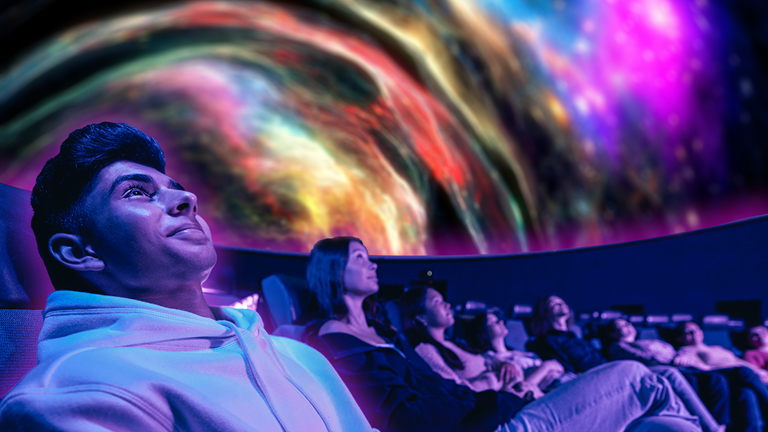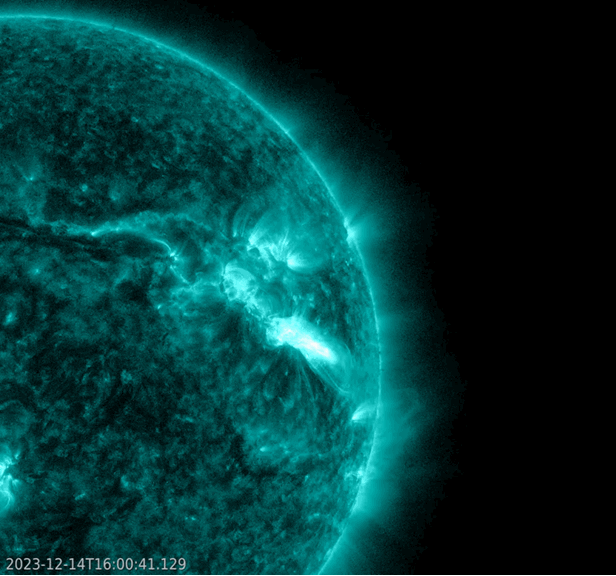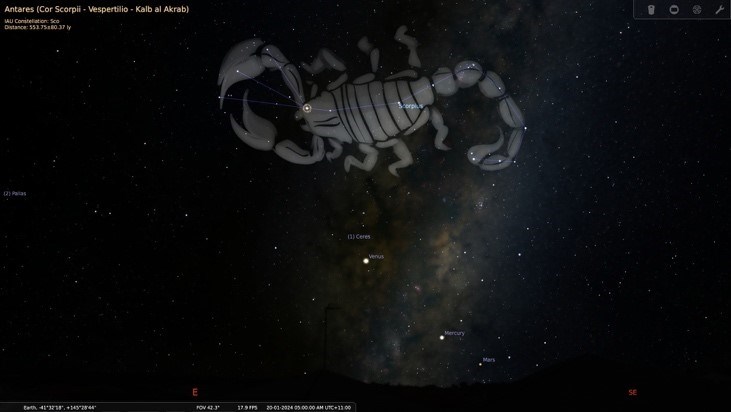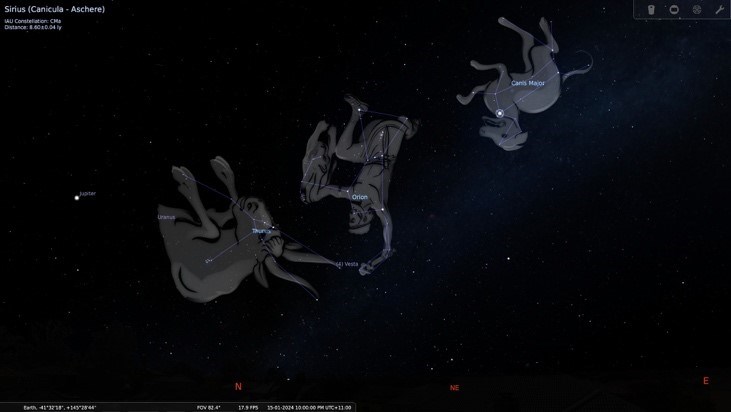Skynotes: January 2024
Upcoming events
Solar Flare a Reminder of Earth’s Vulnerability
NASA’s Solar Dynamics Observatory (SDO) in high orbit detected a major solar flare on December 14 – a demonstration of the power of the sun that underscores our need to understand solar activity which can adversely affect Earth. Flares can range in intensity from least powerful C-type, to intermediate M-type, and the most powerful X-type. December’s was rated X2.8 and was the strongest in over 6 years.
SDO captured a bright flash in an area of sunspots near the Sun’s limb (the white region at right in this sequence). While the solar disc is observed continuously over a wide range of wavelengths, this view in extreme ultra-violet shows the energy output associated with a sunspot and magnetic field lines erupting from the visible surface (photosphere) and unleashing high energy photons and particles into the Sun’s outer atmosphere (corona) and beyond.
Enjoy SDO’s Daily Video of the Sun for today, any date, or in nineteen wavelengths that reveal the Sun in all its various guises.
For two hours this event interfered with short-wave radio and aviation communication in North America and across Earth’s sun-facing hemisphere. More flares and eruptions are expected as the Sun reaches solar maximum in its 11-year cycle of sunspot and solar activity.
These events, especially Coronal Mass Ejections (CME), can disrupt or damage Earth satellites, navigational systems, power grids and terrestrial communications, and even threaten spacecraft and astronauts in space.
Some of the most challenging physics to study involves our local star, the Sun. From a core generating energy from nuclear fusion, the outward flow of energy passes through radiative and convective zones to reach a constantly churning surface. A powerful complex and twisted magnetic field, a rotation faster at the equator than at the poles, and dynamic internal pulsation, all contribute their own influences. Flares and eruptions add energy to an already high temperature corona above its physical surface is. Appreciating the Sun’s processes and energy transfers, and the effects on space weather, is important but not well understood.
Explore more
NASA - Sun Releases Strong Solar Flare
PhysOrg – Biggest solar flare in years
EarthSky – Coronal Mass Ejections
Melbourne Sun times
| Date | Rise | Set | Day length | Solar noon* |
|---|---|---|---|---|
| Monday 1st | 6:01am | 8:45pm | 14:44 hours | 1:23pm |
| Thursday 11th | 6:09am | 8:45pm | 14:35 hours | 1:27pm |
| Sunday 21st | 6:20am | 8:41pm | 14:21 hours | 1:31pm |
| Wednesday 31st | 6:31am | 8:34pm | 14:02 hours | 1:33pm |
*When the sun is at its highest, crossing the meridian or local longitude.
Moon phases
| Phase | Date |
|---|---|
| Third Quarter | Thursday 4th |
| New Moon | Thursday 11th |
| First Quarter | Thursday 18th |
| Full Moon | Friday 26th |
Moon distances
Tuesday 2nd is Lunar apogee (furthest from Earth) at 404,909 km.
Saturday 13th is Lunar perigee (closest to Earth) at 362,267 km.
Planets
Mercury can be seen early in the pre-dawn eastern sky from around 4:30am. This month the planet closest to the Sun, will reach its greatest elongation and be furthest from the sun from our point of view. This offers a good chance to spot this sometimes difficult to observe planet. Below, in this Stellarium view looking East, it is 5am on January 20 with Mercury and Venus and the unmistakable Scorpion above. Mars is likely too faint to see in the pre-dawn sky this month.
See
EarthSky – Mercury, up before sunrise
Venus is getting closer to the Sun but is still visible from 3:40am in the east before fading in the dawn light.
Earth will reach perihelion on January 3rd, its closest point to the Sun in the year and be at 147.1 million km. On July 5th, six month’s later, we will be at aphelion, our furthest point, at 152 million km.
See
EarthSky.org - Earth closest to sun
Timeanddate.com - Perihelion and Aphelion
Mars is not easily seen this month as it is very close to the sun in the east, but the Red Planet will become easier to spot in the early morning skies as we move from January into February.
Jupiter can be seen brightly in the north from 9pm at dusk before it sets in the west by 1:30am
Saturn with its faint yellow hue remains visible in the north-west from 9.30pm before setting by 11pm.
Meteors
While the Quadrantids in the Northern Hemisphere peak on the 4th in the Southern Hemisphere, the Eta Carinids are active from 14th to 27th although fainter with only a few per hour that peak on the 21st. Their radiant, the point from which they appear to originate, is located near the star Eta Carina not far from Southern Cross.
Stars and constellations
Our summer night sky includes two neighbouring galaxies, star clusters, red giant stars, easily recognizable constellations, and the band of the Milky Way with dense star fields and dark interstellar dust clouds.
In the south
The Southern Cross (Crux) and the nearby Pointers (Alpha and Beta Centauri) are easy to spot low to the horizon in early evening. Adjacent to the Southern Cross is the dark dust cloud known as the Coal Sack that forms a veil that blocks the light of more distant stars from reaching us. Enjoy this ESA page and ESA video
High in the south on their own are our two neighbouring small galaxies the Large Magellanic Cloud (LMC) and Small Magellanic Cloud (SMC) at 160,000 and 200,000 light years respectively. From the southern hemisphere they are a treat and always visible in our skies which is not the case for equivalent latitudes in the northern hemisphere.
A recent interpretation is that the two Clouds of Magellan appear not to be orbiting our galaxy as long assumed, but in fact may be making their first pass of the Milky Way after colliding with each other around 300 million years ago. The collision may have distorted them, depleting them of gas and stars, leaving them diminished in their current irregular form.
In the east
The brightest star at night lies directly east - Sirius the principal star in the constellation of Canis Major (Greater Dog). It is 8.6 light years away and therefore a close neighbour to the sun but with twice the mass of our sun, greater size, surface temperature and luminosity.
In the north-east
The Saucepan asterism is easy to spot using the three bright stars as its base. They are the belt of Orion the hunter who is upside down in our southern perspective. Orion’s scabbard or sword sheath (the saucepan’s handle) contains a fuzzy object which is the beautiful Orion Nebula which is where new stars are developing from vast clouds of hydrogen and dust. Two very different stars are also part of Orion; top left is the hot blue giant Rigel as one of his feet, the other is the cooler red giant Betelguese at bottom right which is one of his shoulders.
In the north
An open cluster the Hyades some 150 light years away forms an inverted V which marks the head of Taurus the bull. At its lower right corner is Aldebaran another red giant which is much closer to us at 65 light years. To the left can be seen the more compact cluster of stars known as the Pleiades (or Seven Sisters). These hot blue stars are young, formed together and are only the brightest members of a much larger number of stars all bound together under their mutual gravity.
In Stellarium below for January 15 at 10pm, looking north and north-east, are Jupiter at left, Taurus (with Pleiades and Aldebaran), Orion at centre (with Betelguese), and Canis Major (with Sirius) at right:
International Space Station
ISS orbits every 90 minutes at an average distance of 400 km appearing like a bright star moving slowly across the night sky. Here are some of the brightest passes expected this month over Melbourne and Central Victoria:
Morning
Monday 22nd 5:41am to 5:48am West-North-West to South-East
Tuesday 23rd 4:54am to 4:58am North-North-West to South-East
Heavens Above gives predictions for visible passes of space stations and major satellites, live sky views and 3D visualisations. Be sure to first enter your location under ‘Configuration’.
On this day
1st 1801, the first asteroid, Ceres, was discovered by Giuseppi Piazzi.
2nd 1959, first detection of solar wind by Luna 1 (USSR) as it passed the moon.
4th 1958, the first satellite, Sputnik (USSR), fell back into the atmosphere and disintegrated after 11 weeks in orbit.
4th 1959, first human-made object enters heliocentric orbit, Luna 1 (USSR).
4th 1643, birth of Isaac Newton famous for studies in optics, the reflecting telescope, laws of gravitation and motion, and co-creator of calculus.
5th 2005, discovery of the most massive and second largest dwarf planet, Eris at 2,300 km diameter, by team led by Mike Brown at Palomar Observatory.
7th 1610, Galileo Galilei’s discovery of Jupiter's four largest moons: Io, Europa, Callisto and Ganymede.
8th 1942, birth of Stephen Hawking, theoretical physicist, cosmologist and science celebrity.
11th 1787, discovery of Uranus’s first two moons, Titania and Oberon by William Herschel.
16th 1969, first docking in space and first crew exchange in space between Soyuz 4 and Soyuz 5 (USSR) in Earth orbit.
18th 1916, meteorite falls onto occupied house in Baxter, Missouri (USA).
19th 2006, New Horizons spacecraft (USA) launched to Pluto for its 2015 fly-by.
23th 2003, final communication with Pioneer 10 (USA), first interplanetary probe to Jupiter, which later left the solar system.
25th 2006, first icy-rocky planet discovered orbiting a main sequence star, a red dwarf at 21,500 light years from Earth.
27th 1967, fire in Apollo 1 (USA) command module kills crew of three in ground test at Kennedy Space Centre.
28th 1986, space shuttle Challenger (USA), the 10th shuttle flight, explodes 73 seconds after lift-off killing all seven crew and halting the program for 32 months.
31st 1961, first hominid in space, chimpanzee Ham, in Mercury-Redstone 2 (USA), who survived and lived in zoos until 1983.
31st 1958, discovery by James Van Allen of radiation belts of charged particles from the Sun that surround Earth and which now bear his name.
31st 1958, Explorer 1 the first successful American satellite launch, and first satellite to carry instruments into space.



